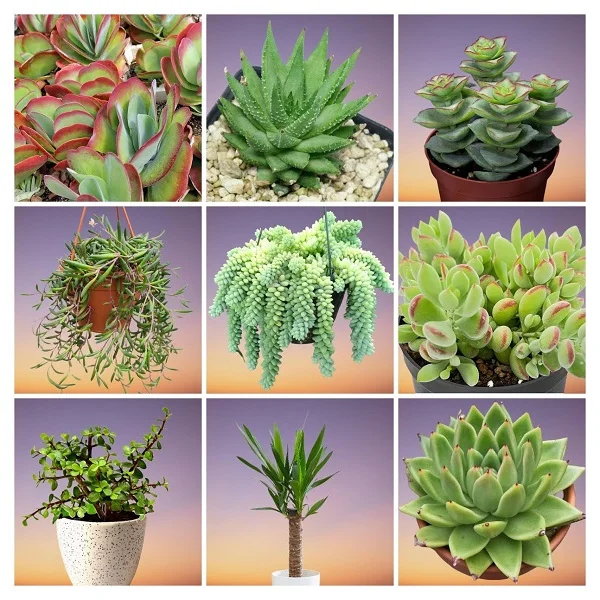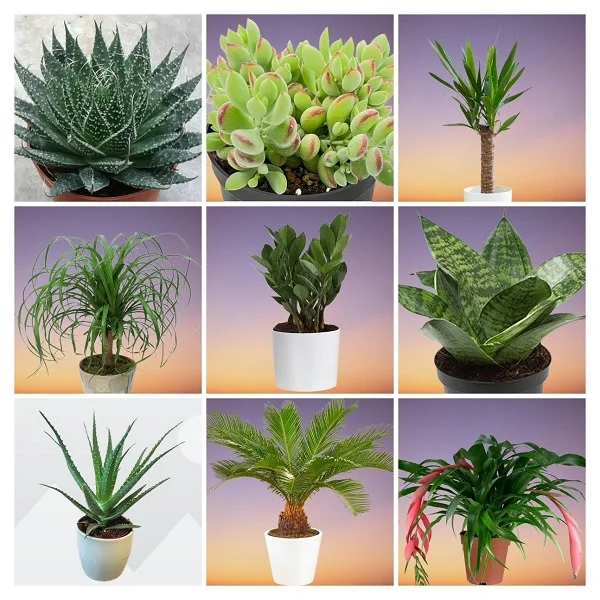Miniature Pine Tree (Crassula tetragona) Care Indoors, Propagation & Common Problems
Some links in this post may be affiliate links
Crassula tetragona (Miniature Pine Tree) thrives in bright light with some sunlight, average warmth and humidity, and moderately moist, rich, well-drained soil coupled with monthly feeding in spring and summer.
Crassula tetragona also called Mini Pine Tree is among the popular Crassula varieties and bear green to dark-green leaves which occur in crossed pairs.
Mini Pine Tree is an upright, naturally branching, shrubby succulent plant with thin narrow stems and leaves which look-like needles. The stem is woody with a brown bark as it matures and is highly branched. This form of growth makes this plant perfect for a bonsai.
The common name, 'Miniature Pine Tree', is in reference to the naturally branching form and interesting leaf structure of this spectacular plant.
Crassula tetragona is nicknamed the "miniature pine tree" for its popular use as a "pine tree" in Bonsai. The specific name, 'tetragona' is in reference to the phyllotaxy (the arrangement of the leaves on the stem) of the leaves.
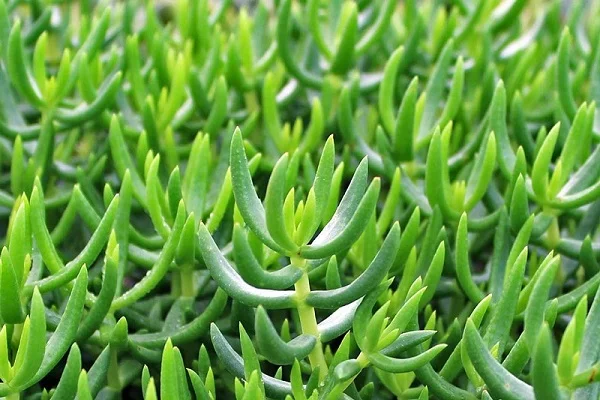
Botanical name: Crassula tetragona
Family: Crassulaceae
Common names: Miniature Pine Tree, Mini Pine Tree
Origin
Crassula tetragona is native to southern Africa from the Orange River boundary of Namaqualand to beyond the Kei River in the Eastern Cape.
Size & Flower
Mini Pine Tree can grow to a height of 3-4 feet and a spread of about 2-3 feet. It blooms from spring to summer though it is unlikely to flower indoors. The flowers are small, cream white clusters borne at the branch tips once the plant matures, usually, at the age of 4 years.
Air Cleaning
Miniature Pine Tree exhibits CAM (Crassulacean Acid Metabolism) where the plants harvest Carbon dioxide at night and use it during the day for photosynthesis.
As the plants photosynthesize (make food) during the day, the plants store the oxygen they produce in the process and release it at night. Therefore, if you keep this plant in your living spaces, it will increase the oxygen concentration and thereby clean (freshen) the indoor air.
Is Crassula tetragona toxic?
Yes. Crassula tetragona like its cousin, Jade Plant, is considered toxic to both humans and pets as indicated by ASPCA. If ingested it can cause nausea, vomiting and diarrhea. Keep the plant away from the reach of children and pets.
Where to Buy
If you would like to add these plants to your collection, Crassula tetragona is available online on Etsy (Link to Etsy).
How to Care for Crassula tetragona Indoors
To care for Crassula tetragona indoors, give it bright light with 4-6 hours of direct sunlight, warmth of 15-260C, humidity of 50-55% and moderately moist, rich, well-drained soil coupled with monthly feeding in spring and summer.
Miniature Pine Tree has no need regular repotting as it grows best when pot-bound. Pruning is necessary to keep the plant neat, to discourage pest and disease infestations and to rejuvenate growth. Keep reading for more on these growing conditions and how to achieve them.
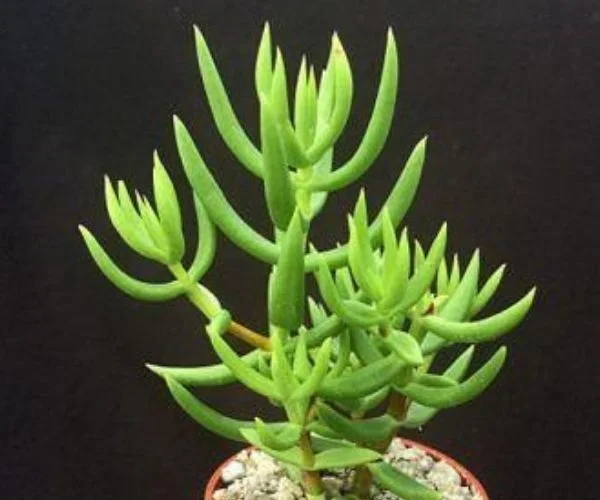
Light Requirements
Does Crassula tetragona need sunlight?
Yes. Crassula tetragona grows best in bright light with at least 4-6 hours of direct sunlight. Keep it away from too hot direct sunshine to avoid scorching of the leaves.
If the light is not adequate, the plant will grow leggy with elongated stems, wide spaces between the leaf nodes and small pale leaves. Where the natural lighting is not sufficient, you may use full spectrum grow lights to supplement it.
Regularly rotate the pot to ensure that the plant receives light on all sides for even growth and to prevent lopsided growth.
You can grow the Mini Pine Tree outdoors, however, gradually acclimate it and place it in a shaded place to prevent scorching the leaves.
Watering
How often should I water Crassula tetragona?
Water Crassula tetragona liberally in spring and summer while allowing the top half of soil to dry out between waterings to keep the soil moderately moist. Avoid overwatering to prevent rotting, yellowing and leaf drop.
Decrease watering in fall and winter as growth is minimal to maintain the soil barely moist. Do not let the soil dry out completely to prevent wilting, yellowing and leaf loss.
Use water that is at room temperature to avoid cold shock which can cause stunted growth and sudden leaf loss. Only use chlorine-free water like rainwater to prevent browning of the leaves.
Make sure that the pot has a drainage hole and the soil is fast-draining to prevent waterlogging as it can result in rot-root and death of the plant.
Take care not to wet the foliage as it can lead to fungal diseases; water from the bottom instead. Discard excess water from the bottom saucer to prevent the soil from getting soggy.
Temperature & Humidity
Crassula tetragona prefers an average warmth of 15-260C in spring and summer and a minimum of 100C in fall and winter.
Keep it away from sources of drafts like AC units, heat sources, windy windows and doors among others as they can cause reduced growth, brown leaf spots and leaf loss.
Miniature Pine Tree flourish in a humidity of 50-55%; it has no need for extra humidity. Do not mist the leaves and maintain good air circulation to prevent fungal disease infestations which are prevalent in damp, poorly ventilated conditions.
Fertilizer
Feed Crassula tetragona with a cactus and succulents fertilizer monthly in spring and summer for a lush growth. Take care not to overfeed as the plant is a slow grower.
Withhold feeding in fall and winter as growth is minimal and feeding at this time can result in fertilizer burn and death of the plant.
Regularly, flush out excess salts by running a stream of water through the soil until it drains through the drainage hole. Let it run for about 10 minutes to clear most of the salts.
Potting Medium
The best soil for Miniature Pine Tree should be rich in organic matter, loose and free-draining to prevent it from getting soggy. The soil should be loose enough to allow water to drain out fast enough. Most Cactus and succulents mixes are ideal for this plant.
Repotting
Repot Crassula tetragona at the beginning of the growing season (spring to early summer), only when it becomes crowded in its current pot.
Use a pot that is only one size larger than the current one to avoid overpotting. Confirm that the pot has a drainage hole to prevent the soil from getting soggy as it can lead to root-rot.
Select a clay pot which is porous and therefore allows the soil to dry out faster which prevents it from staying wet for too long. Take a look at these terracotta pots on Amazon.
Pruning & Grooming
Pruning Miniature Pine Tree involves removal of any dead or diseased leaves to keep it neat and also discourage pest and disease infestations. Snip the leaves at the base with a sterilized knife or pair of scissors to prevent diseases transmission.
Cutback the plant at the beginning of the growing season if it is too straggly to rejuvenate growth. Minimize the number of cuts as much as possible to avoid unnecessary injuiries to reduce disease infestations.
Regularly clean the leaves by damp-wiping with a soft cloth to get rid of dust and discourage pest and disease infestations. Take care not to damage the fragile leaves.
Crassula tetragona Propagation
Crassula tetragona (Miniature Pine Tree) is propagated from offsets, leaf cuttings or stem cuttings at the beginning of the growing season for faster establishment.
1. Propagating Crassula tetragona from offsets
- Carefully seperate the offset from the mother plant by cutting with a clean, sharp knife while ensuring that the offset has adequate roots.
- Fill a small pot one thirdway with a well-draining soil and moisten it slightly.
- Position the offset in the center of the pot and continue to cover the roots with the soil while firming the soil lightly. Maintain the offset at the same soil level as it was in the previous pot.
- Place the set-up in a warm, well-lit place away from direct sunlight to prevent scorching.
- Maintain good air circulation to discourage fungal diseases.
- Keep the soil slightly moist through out until the new plant is well established after which you can begin routine care.
2. Propagating Crassula tetragona from leaf cuttings
- Take leaf cuttings complete with the petiole from a healthy plant.
- Allow the leaf cutting to dry out (callus) for a few days to prevent rotting.
- Fill a rooting container with a fast-draining soil and wet it slightly. Ensure the container has a drainage hole to avoid rotting.
- When calloussed, lay the leaf cutting on moistsoil while ensuring that the cut end does not come into contact with the soil to prevent rotting.
- Postion the set up in a warm, well-lit place away from direct sunlight to prevent scorching of the leaf cuttings.
- Maintain the soil slightly moist through out and ensure that there is good air circulation to prevent fungal diseases.
- With time, the leaf cutting will form roots and eventually a small rosette will form at the base of the leaf cutting. This may take from 4-6 weeks.
- Allow substancial growth of the rosette before transplanting the new plant into its own pot after which you can begin routine care.
3. Propagating Crassula tetragona from stem cuttings
- Take 4-6 inches stem cuttings from a healthy plant and allow the cutting to dry out (callus) for a few days to prevent rotting.
- Fill a small pot with a fast-draining soil and moisten it slightly. Use a pot with a drainage hole to avoid rotting.
- Once callused, insert 2-3 inches of the lower cut end of the stem cuttings in the moist soil.
- Place the set up in a well-lit, warm place away from direct sunlight to prevent scorching.
- Ensure good air circulation to discourage fungal diseases.
- Maintain the soil slightly moist until the stem cuttings have rooted. Rooting may take upto 4 weeks.
- Allow substancial growth before transplanting the new plant into a pot one size larger after which you can begin routine care.
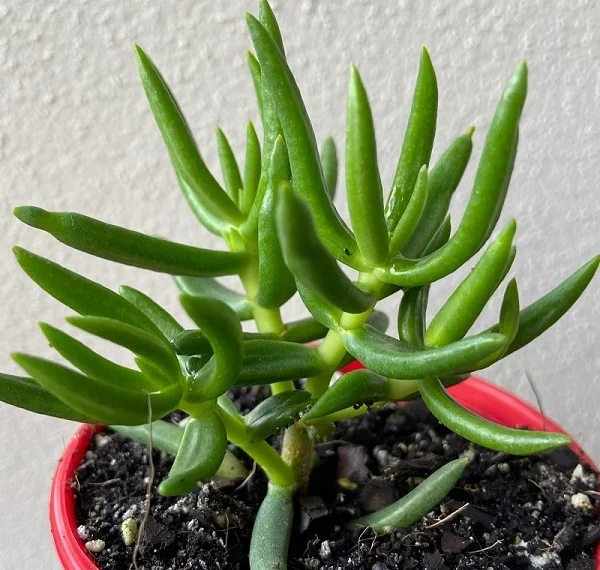
Crassula tetragona Problems & Solutions
Crassula tetragona (Miniature Pine Tree) problems are plant dying, leaf drop, leggy growth, pests and diseases among others. Keep reading for more on these problems and how to fix them.
Plant dying
Why is my Crassula tetragona dying?
Your Crassula tetragona is dying due to root-rot which is prevalent in soggy soil. The disease is characterized by yellowing and wilting of the leaves which is rapidly followed by browning and plant collapse.
How to fix it
- Carefully slip the plant out of its pot and inspect the roots; brown-black mushy roots indicate root-rot.
- Trim the rotten roots and treat the healthy roots with a copper-based fungicidal solution as indicated by the manufacturer.
- Repot the plant in fresh soil and a fresh pot. Use a pot with a drainage hole and fast-draining soil to prevent it from getting soggy.
- Place the plant in very bright light and stop watering for a few days to give the plant enough time to recover. After the dry period, resume routine care.
Leaf drop
Why is my Crassula tetragona dropping leaves?
Your Crassula tetragona is dropping leaves due to too little light, inconsistent watering, soggy soil, drafts, use of cold water, nutrients deficiency, pest infestations, excessive touching or aging.
How to fix it
Too little light: Move the plant to bright light with 4-6 hours of direct sunlight or use a grow light if you do not have adequate light in your home.
Inconsistent watering: Do not water on a schedule. Water when the top 2-3 inches of soil dry out but never allow the soil-ball to dry out completely.
Soggy soil: Use well-draining soil and a pot with a drainage hole.
Drafts: Keep the plant away from sources of drafts like windy doors, drafty windows, AC units, hot air vents among others.
Nutrients deficiency: Feed the plant with a cactus and succulents fertilizer every 4 weeks in spring and summer.
Use of cold water: Use water that is at room temperature to prevent cold shock.
Pest infestations: Regularly inspect the plant for pests and carry out timely control measures.
Excessive touching: Keep the plant away from the line of traffic and avoid unnecessarily moving it around and take care when moving it.
Aging: This is a natural process. As the lower leaves mature, they turn yellow, brown and eventually drop off.
Leggy growth
Leggy growth on Miniature Pine Tree is caused by insufficient light, underwatering or nutrients deficiency.
How to fix it
Insufficient light: Position the plant in bright light with 4-6 hours of sunlight or instal a grow light if the natural lighting is not enough.
Underwatering: Water when the top half of soil feels dry to the touch. Never allow the soil to dry out completely.
Nutrients deficiency: Feed the plant with a cactus and succulents fertilizer every 4 weeks in spring and summer.
Pests
Common pests on Crassula tetragona are scale insects, mealybugs and spider mites which are prevalent in dry, stuffy conditions.
How to fix it
- Isolate the affected plant to prevent spread to the other plants.
- Treat the infested plant with neem oil or an insecticidal soap as per the manufacturers' instructions on the labels.
- Regularly check underneath and between the leaves for these pests and carry out timely control measures.
- Maintain the plant well pruned and raise humidity to reduce the pest infestations.
Diseases
Miniature Pine Tree Crassula is prone to leaf spot disease, powdery mildew and black leg disease which are prevalent in overwet conditions coupled with poor air circulation.
How to fix it
- Isolate the affected plant to minimize spread to the other plants.
- Treat the affected plant with neem oil as per the manufacturer's instructions.
- Maintain free air circulation to discourage the diseases.
- Water from the bottom to avoid wetting the leaves.
- Always allow the soil to dry out between waterings.
- Use a pot with a drainage hole and fast-draining soil to prevent waterlogging.
You liked it? Share on social media.
Related Content
Amazon Associates Disclosure
Homeplantsguide.com is a participant in the Amazon Services LLC Associates Program, an affiliate advertising program designed to provide a means for sites to earn advertising fees by advertising and linking to amazon.com.




